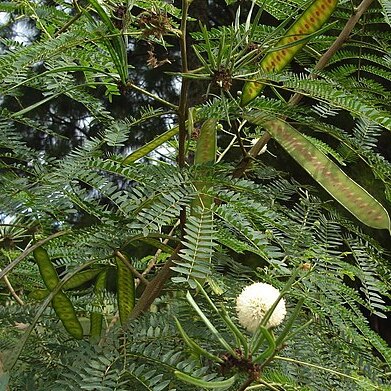Trees or shrubs, unarmed. Leaves bipinnate; a gland often present at junction of lowest pair of pinnae, petiole and rhachis otherwise eglandular, or rarely with glands between other pairs of pinnae; pinnae each with one to several or many pairs of leaflets. Inflorescences of round heads, pedunculate, axillary, 1–3 together, often racemosely aggregated. Flowers hermaphrodite, sessile. Calyx gamosepalous with 5 teeth. Petals 5, free, pubescent to glabrous outside. Stamens 10, fertile. Anthers eglandular at apex (except in the extra-African L. forsteri). Ovary pubescent or sometimes glabrous. Pods oblong or linear-oblong, compressed, usually thinly sub coriaceous, splitting into 2 non-recurving valves. Seeds lying ± transversely in the pod, compressed, brown, glossy, unwinged, with endosperm.
Unarmed shrubs or trees. Stipules not spinescent, caducous. Leaves bipinnate, not sensitive to the touch, rachis and pinnae usually with extrafloral nectaries; leaflets opposite. Inflorescences composed of pedunculate glomerules, either single or a few axillary, or arranged in terminal racemes. Flowers pentamerous, uniform, male or bisexual. Calyx connate, valvate. Petals free, valvate. Stamens 10, free, anthers eglandular (hairy in L. leucocephala). Pod membranous, straight, dehiscent, exocarp not separating from the endocarp. Seeds brown, compressed, with areole, wingless, aril absent, endosperm present.
Trees or shrubs, evergreen, unarmed. Leaves bipinnate; stipules deciduous, small, setaceous; petiole often glandular; leaflets opposite, numerous and small, or few and larger, oblique. Heads solitary or fasciculate, axillary, globose, pedunculate; bracts usually 2. Flowers sessile, usually bisexual. Calyx campanulate, 5-toothed. Petals 5, free or nearly so. Stamens 10, free, exserted; anthers apically eglandular. Ovary stipitate; ovules numerous; style filiform. Legume stipitate, broadly linear, plano-compressed, leathery, 2-valved, continuous within. Seeds transverse, ovoid, flat.
Unarmed trees or shrubs. Leaves bipinnate, often with extrafloral nectary on main axis; stipules small, triangular; pinnae to 8-jugate with numerous pairs of opposite leaflets. Inflorescence comprising axillary, solitary, globular, pedunculate clusters or clusters in 2s or 3s or often in racemes. Flowers 5-merous, staminate or perfect; perianth valvate; sepals connate; petals free. Stamens 10, free; anthers eglandular. Pod oblong to linear-oblong, flat, membranous, glabrous, dehiscing on both sutures. Seeds flat, glossy brown; pleurogram present.
Leaves 2-pinnate; a gland often present at the junction of the lowest pair of pinnae, petiole and rhachis otherwise eglandular, or rarely with glands between other pairs of pinnae; pinnae each with one to several or many pairs of leaflets.
Pods oblong or linear-oblong, compressed, usually thinly subcoriaceous, splitting into 2 non-recurving valves.
Inflorescences of rounded heads, pedunculate, axillary, 1-3 together, often racemosely aggregated.
Seeds lying ± transversely in the pod, compressed, brown, glossy, unwinged, with endosperm.
Anthers eglandular at the apex (except in the extra-African L. forsteri).
Petals 5, free, pubescent to glabrous outside.
Ovary pubescent or sometimes glabrous.
Calyx gamosepalous with 5 teeth.
Flowers hermaphrodite, sessile.
Trees or shrubs, unarmed.
Stamens 10, fertile.

